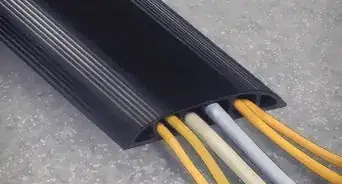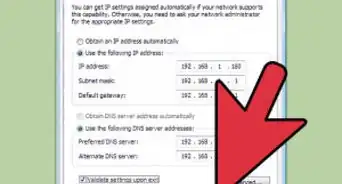wikiHow is a “wiki,” similar to Wikipedia, which means that many of our articles are co-written by multiple authors. To create this article, volunteer authors worked to edit and improve it over time.
This article has been viewed 55,546 times.
Learn more...
SOLE refers to a Self Organized Learning Environment. It is the brainchild of Sugata Mitra, Professor of Educational Technology at Newcastle University in the UK. Through SOLE, children ages 8 through 12 direct the learning process and follow pathways that many of the traditional educational approaches do not make room for. SOLE relies on the use of technology, collaboration and encouragement as the basis for encouraging learning. Provided you're able to connect to the internet at school, SOLE can be used as the way of learning for your class. Setting it up at school is a simple process that can complement the classwork normally undertaken.
Steps
Understanding Your Role
As a teacher, you'll already be fully aware of the importance of your role as an educator and as a person who inspires a love of learning. Your enthusiasm for learning will already be setting a positive tone within the classroom. From here, there are some other ways to help the class participants enjoy the SOLE activities even more.
-
1Be openly curious along with the students. In class, students can sometimes be worried that they might ask a "stupid question". This can stifle learning if children are worried that their peers and teacher are judging them unfairly for a dumb question. As a teacher, you can show that there is never such a thing as a stupid question, and you can help children to see that it is often the person who has the courage to ask a question who is able to get answered what everyone else was wondering!
- Have a class discussion about the worth of asking questions. Ask them how they feel about asking questions, who they are most likely and least likely to ask questions around, and why. This will help them to explore what may be holding them back from asking questions in different situations of their life.
- Lead discussions by asking questions and getting class participants to do the same with each other.
- Invite your class to be a question zone, one where nobody's question is ever ridiculed.
- Help class participants to formulate questions themselves. Some of the participants may have a difficult time with question asking as a skill, so it's useful to give them the tools to do this.
-
2Make the space for SOLE activities as part of the regular classwork. Once a week, choose a one hour period during which SOLE activities are pursued as part of the usual coursework. The activities can even be based around existing coursework obligations that if that assists you with finding the space for it.
- The SOLE activity will require about an hour to complete, although the first session may take a little longer due to you needing to explain what SOLE activities are about.
Planning the SOLE
-
1Follow the approach of question, investigation and review. This simple approach gives plenty of room for discovery, research, creativity, analysis and conclusions.
-
2Determine a question. Make the question an exciting one that sparks the imagination and interest of the class participants. The best questions tend to be those that are large, open-ended, difficult and interesting:
- Encourage class participants to consider theories rather than concrete answers. If the question seems unanswerable, children will be encouraged to posit many possibilities, pushing their thinking boundaries.
- Broader, harder questions promote deeper and longer discussions.
- Consider using a mix of familiar things and less well known things. For example, you might ask questions related to coursework already covered along with questions about things the class participants are yet to learn about.
- For many ideas of good questions, check both How to formulate questions for SOLE activities and the SOLE guide at http://www.ted.com/pages/sole_toolkit.
-
3Provide a prompt to accompany the question. There are many possibilities here, such as reading a brief information sheet, showing a video, playing music or audio, showing images, etc., all things related to the question. Basically, look for things that spark curiosity and cause the class participants to want to dig deeper and look for the solutions.
The Class's First SOLE activity
-
1Set aside approximately an hour. You might need a little more or less time, that depends on the question, the context and the children involved.
-
2Explain what SOLE is all about. The first time you perform a SOLE investigation, you'll need to talk about the process and what it means. Explain how it differs from a typical lesson and what sort of learning will be occurring. Focus strongly on how this is an exercise is self organization, making it clear that you'll be standing back and simply awaiting the outcomes.
-
3Divide the class into groups. When forming groups, bear in mind that about 4 person per computer is optimal for the best learning results.
- For each group, delegate a "peer helper". The peer helper is responsible for delegating within the group, such as resolving issues, problem-solving, etc. This, in itself, is an important learning process in helping peers to get along and learning to lead.
-
4Ask the question (see above).
-
5Set aside about 40 minutes for the investigation part of the SOLE activity.
- Ask the class groups to keep records of their investigation. This can be notes, photos, quotes, audio recordings, drawings, diagrams, print-outs, etc.––basically, whatever they feel documents the investigation in the way that explains their findings. These notes will help them to give their presentation at the next stage.
- When the children are exploring the questions, leave them to it. The peer helper should help to steer the group and resolve issues. Only step in if it's really necessary during the investigation phase.
-
6Review. After the 40 minutes are up, ask the class groups to come back together as a whole class. Sit down together. Ask them to present their findings and talk about how the investigation went. As a teacher, facilitate their discussion by asking about the investigation, listening and encouraging other groups to make observations. Your role is as a moderator––do not add value to their presentation. For example, if you feel that the children are not answering on point, simply ask them to think carefully about whether they're answering the question when giving their presentation.
- Ask what conclusions/answers/ideas the children have reached, on a group-by-group basis. When doing this, encourage each participant to talk, not just the one most willing to summarize the issues. Even within the group, there will be differences of perspective.
-
7Summarize. After the children have had a good chance to give their presentations and explore their responses, then you can summarize what the groups have said. This is the time when you can add value.
- Ask the participants what they felt about the experience. Ask for comparisons with the children's own lives/experiences and knowledge, etc.
- Ask the participants what they felt they did well during the investigation, including noting what others did well. And ask them what they'd do differently the next time––it's as important to learn about what doesn't work as much as what does.
- Ask the groups what they feel about the answers and ideas of other groups.
Future SOLE activities
-
1Continue using SOLE in your classroom as a regular activity. Even excursions as a class can form part of a SOLE investigation, such as museum or gallery visits.
-
2Encourage your students to take up SOLE activities at home. Help them to explore learning beyond the classroom and as part of their everyday lives.
- You could even consider holding a SOLE information session for parents one evening. Show them how the SOLE works and give them some ideas for running SOLE activities in the home environment.
- Encourage after-school programs within your school environment to follow SOLE activities as one of the options for children to pursue after class.
Community Q&A
-
QuestionCan age norms be flexible or will it hinder the learning?
 Community AnswerIt depends on the age difference. If it is a large gap consider aspects for both sides/age groups to engage them correctly.
Community AnswerIt depends on the age difference. If it is a large gap consider aspects for both sides/age groups to engage them correctly.
References
- http://www.ted.com/pages/prizewinner_sugata_mitra – research source
- http://www.ted.com/pages/sole_toolkit – research source
- http://www.youtube.com/watch?v=SiGbfhnvT4Q – research source
-at-School-Step-1-Version-2.webp)
-at-School-Step-2-Version-2.webp)
-at-School-Step-3-Version-2.webp)
-at-School-Step-4-Version-2.webp)
-at-School-Step-5-Version-2.webp)
-at-School-Step-6-Version-2.webp)
-at-School-Step-7-Version-2.webp)
-at-School-Step-8-Version-2.webp)
-at-School-Step-9-Version-2.webp)
-at-School-Step-10-Version-2.webp)
-at-School-Step-11-Version-2.webp)
-at-School-Step-12-Version-2.webp)
-at-School-Step-13-Version-2.webp)
-at-School-Step-14-Version-2.webp)
-at-School-Step-15-Version-2.webp)
-at-School-Step-16-Version-2.webp)


























































